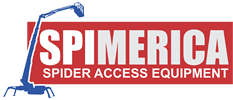A spider lift is an ideal solution when working on great heights indoors, but can also be used on construction sites outdoors, in any weather condition. The lift is specially designed to access areas that more traditional cherry pickers can’t reach, and is often used instead of traditional and expensive scaffolding systems. Its light weight, flexibility, versatility and movability guarantees workers access to any small or narrow spot, effortlessly. Spider lifts are the ideal aerial work platform to perform tasks at great height in limited spaces. With its four legs, a spider lift provides extra stability at every construction site. The light weight that characterizes this type of aerial platform makes the spider lift ideal for working in spaces that are easily damaged, for example when performing maintenance tasks indoors.
When aerial work platforms are used correctly, they are not dangerous. Often times they are set up on uneven ground that is not suitable for equipment that carries the risk of tipping. If you are going to operate a scissor lift, you should carry out or have someone carry out a ground assessment. This will ensure that the ground you use your scissor lift on is safe and secure. If ground conditions are good, the risk is lowered significantly. If the ground is loose and uneven, it is not suitable for operating a scissor lift. No matter how much safety equipment your workers use, they will sustain serious injuries if the machine tips onto its side.
While uneven ground is a common cause of tipping, the most common cause is misuse. If your workers drive with the platform elevated, balance will be compromised and the machine will likely tip. Another example of misuse is when workers hang items on the guardrails, over pack the platforms and exceed the weight capacity, and sit on the guardrails. All of these actions compromises the balance of the machine and can cause it to overturn.
If you and your staff follow the safety guidelines, misuse will not be a problem. In this situation, injury can be avoided by simply following the rules. Worn tires can also cause tipping, which is why you should have your tires and the rest of your construction equipment checked often. Pay attention to warning lights and have routine maintenance performed on your machine regularly.
If your staff exceeds the load capacity, the machine will become damaged. The motor could give out or the supports and balances could be compromised. These damages could end in disaster if they happen while people are operating the machine. If you constantly find yourself exceeding or coming close to the load capacity, it is time for you to purchase a scissor lift with a larger weight capacity.
If you use your scissor lift for a purpose that it was not intended for, the scissor lift will likely sustain damage or even overturn. Also, using scissor lifts that are in poor condition is a recipe for disaster. Maintenance should be performed on a regular basis. Usually every 6 months is a good schedule to follow under normal use. If you know your scissor lift is damaged, do not let workers operate it. The machine could fail and overturn, which could seriously injure your workers.
Spider Lift & Aerial Platform Safety Tips to Remember:
• Do not exceed the load-capacity limits. Take the combined weight of the worker(s), tools and materials into account when calculating the load.
• Do not use the aerial lift as a crane.
• Do not carry objects larger than the platform.
• Do not drive with the lift platform raised (unless the manufacturer’s instructions allow this).
• Do not operate lower level controls unless permission is obtained from the worker(s) in the lift (except in emergencies).
• Do not exceed vertical or horizontal reach limits.
• Do not operate an aerial lift in high winds above those recommended by the manufacturer.
• Do not override hydraulic, mechanical, or electrical safety devices.
The top aerial lift hazards are electrocutions, falls from elevations, tip-overs, collapses, being struck by falling objects, ejections from an aerial lift platform, entanglement, and contact with ceilings, power lines, and other objects. These hazards can put workers at risks of accidents, injuries, and fatalities. Yet, with OSHA-approved aerial lift certification training, workers can limit the risk that any of these hazards can cause such issues to occur.
If your business employs construction workers who operate aerial lifts or are consistently around them, it is essential for them to complete an OSHA-approved aerial lift certification course and learn about the manlift hazards that cause injuries and deaths every year. Enroll your workers in aerial lift safety training, and they’ll be properly prepared to recognize and avoid common hazards associated with aerial lifts.
About Spimerica – Spider Lifts & Aerial Access Equipment North America
SPIMERICA is active in the sales of rental of a variety of industrial machines and equipment including spider platforms, aerial work platforms, elevating work platforms, mobile elevating work platforms,
Spimerica is managed by industry professional Ben Taft. Ben Taft leads Spimerica with extensive experience in the construction rental industry and in the manufacturing sector. Spimerica offers accessibility options to facilitate safer work environments and improve efficiencies within workplace productivity by providing world class spider booms and cranes to the USA Rental Industry market.
Spimerica is the authorized Palazzani dealer for the majority of the US, representing the highest level of spider booms and spider cranes in the industry. Spider booms range from 55ft to 170ft, providing the safest solution at heights you need to reach. Spimerica is committed to representing the most innovative, dependable and trustworthy solutions in our industry.




